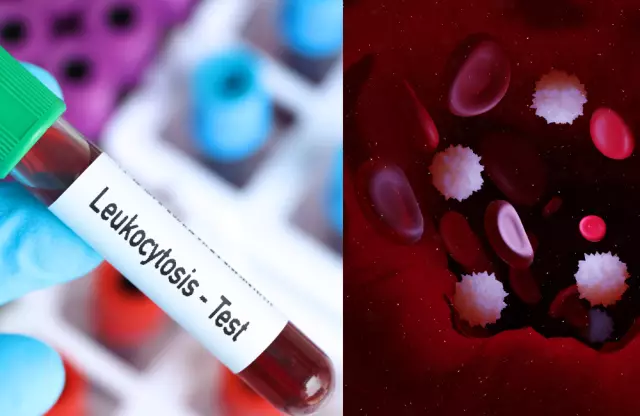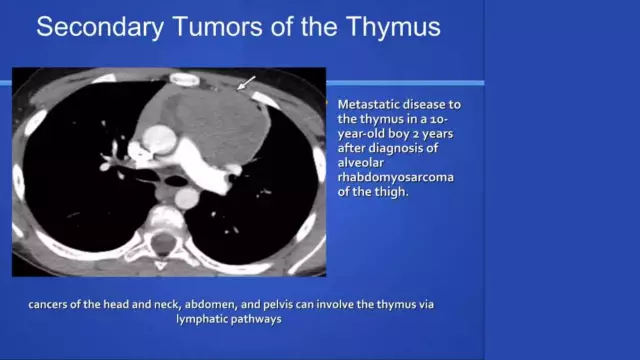- Author Rachel Wainwright [email protected].
- Public 2023-12-15 07:39.
- Last modified 2025-11-02 20:14.
Leukocytosis

Leukocytosis is a condition characterized by an excess of white blood cells (i.e. white blood cells) in the blood.
White blood cells are produced in the bone marrow and are part of the human immune system, protecting us from the invasion of "enemies" and preventing the proliferation of abnormal cells.
General information
The number of leukocytes in the blood is not a constant value, it increases with emotional or physical exertion, sudden changes in ambient temperature, intake of protein foods, as well as diseases. In the case of a disease, leukocytosis is pathological, while an increase in the number of leukocytes in a healthy person is physiological leukocytosis.
A significant increase (up to several hundred thousand) in the number of leukocytes usually indicates a serious blood disease - leukemia, and an increase to several tens of thousands indicates an inflammatory process.
Causes of leukocytosis
The main causes of leukocytosis include:
- Acute infection is the most common cause of leukocytosis;
- Chronic inflammation. In the process of fighting leukocytes with dangerous bacteria that have entered the body, an inflammatory process begins. Under some conditions, this process can take on a chronic nature, as a result of which the level of leukocytes is constantly increased;
- Tissue damage from trauma;
- Improper nutrition;
- An overreaction from the immune system - can develop in people who have severe allergies or autoimmune diseases;
- Disorders associated with damage to the bone marrow; it is in it that leukocytes are produced;
- Stress, prolonged or very strong psychological stress;
- Certain medications.
The most common causes of leukocytosis in children are:
- Infectious diseases;
- Improper nutrition;
- Excessive physical activity;
- Stress.
In addition, we must not forget that, although rarely, acute leukemia can be the cause of leukocytosis in children.
Types of leukocytosis
Leukocytosis can be true or absolute (with an increase in leukocytes or mobilization of their reserves from the bone marrow), as well as redistributive or relative (an increase in the number of leukocytes as a result of blood clotting or their redistribution in the vessels).
There are also the following types of leukocytosis:
1. Physiological leukocytosis: observed after physical exertion, eating, etc.;
2. Pathological symptomatic leukocytosis: occurs in some infectious diseases, pyoinflammatory processes, as well as as a result of a certain reaction of the bone marrow to tissue decay, which caused toxic effects or circulatory disorders;
3. Short-term leukocytosis: occurs as a result of a sharp "release" of leukocytes into the blood, for example, under stress or hypothermia. In such cases, the disease is reactive, i.e. disappears along with the cause of its occurrence;

4. Neurophilic leukocytosis. This condition is most often due to an increase in the formation and release of neutrophils into the blood, while an increase in the absolute number of leukocytes is noted in the vascular bed. It is observed in acute infection, chronic inflammation, as well as myeloproliferative diseases (blood diseases);
5. Eosinophilic leukocytosis develops as a result of the acceleration of the formation or release of eosinophils into the blood. The main causes are allergic reactions, including to food and drugs;
6. Basophilic leukocytosis is caused by an increase in the formation of basophils. Observed during pregnancy, ulcerative colitis, myxedema;
7. Lymphocytic leukocytosis is characterized by an increase in blood lymphocytes. It is observed in chronic infections (brucellosis, syphilis, tuberculosis, viral hepatitis) and some acute (whooping cough);
8. Monocytic leukocytosis is extremely rare. It is observed in malignant tumors, sarcoidosis, and some bacterial infections.
Symptoms of leukocytosis
Leukocytosis is not an independent disease, and therefore its symptoms coincide with the signs of those diseases that caused it. In children, leukocytosis is often asymptomatic, which is why doctors recommend that parents periodically donate the child's blood for analysis in order to detect abnormalities in the blood composition at an early stage.
The most dangerous, although the rarest type of leukocytosis is leukemia, or blood cancer, and therefore it is necessary to know its symptoms in order not to miss the onset of the disease. So, with leukemia, the common symptoms of leukocytosis are as follows:
- Unreasonable malaise, weakness, fatigue;
- Increased body temperature, increased sweating at night;
- Spontaneous hemorrhage, frequent bruising, bruising;
- Fainting, dizziness;
- Pain in the legs, arms, and abdomen;
- Labored breathing;
- Poor appetite;
- Unexplained weight loss.
If you have found two or more of the listed symptoms in yourself, you should consult a doctor and take a blood test.
Leukocytosis treatment
Treatment methods for leukocytosis completely depend on the disease that caused it. In infectious processes, as a rule, antibiotics and anti-inflammatory drugs are prescribed, antihistamines and steroids can be prescribed to relieve an allergic reaction. Chemotherapy drugs are used to treat leukemia. In some cases, leukopheresis can be prescribed - the extraction of leukocytes from the blood, after which the blood is transfused back to the patient.
It should be remembered that the treatment of leukocytosis cannot be carried out without finding out the cause that caused it.
YouTube video related to the article:
The information is generalized and provided for informational purposes only. At the first sign of illness, see your doctor. Self-medication is hazardous to health!






